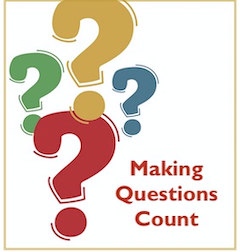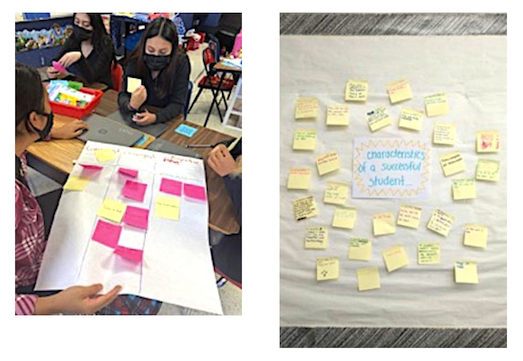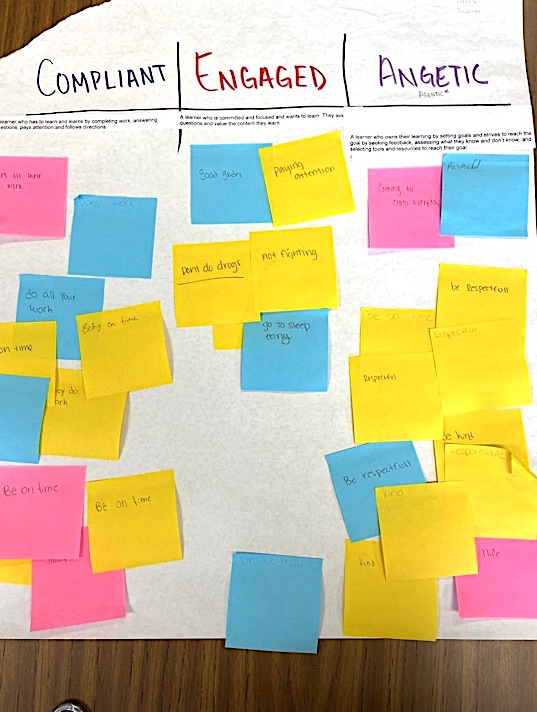Co-Create a Learning Culture with Students
Welcome to our series on how to get the most learning out of classroom questioning. The first installment explored ways to use questioning to strengthen teaching. Now the authors look at the critical importance of building a learning culture early in the year, rather than have students develop a “willy-nilly” culture of their own.
By Jackie A. Walsh, Emily Brokaw, and Anna Salazar

Most teachers are familiar with the research findings that tie the systematic teaching of rules and procedures to these outcomes. They emerged from studies conducted in the early 1980’s by researchers at the University of Texas. The compelling findings continue to form a cornerstone in almost all literature on classroom management.
While the Texas researchers focused on developing norms for behavioral conduct, the same principles hold true for the establishment of academic norms:
Setting explicit guidelines for engagement and interactions during the first month of school is a critical part of building a culture that supports the learning of all students.

Jackie Walsh
This involves crafting a limited number of guiding statements appropriate for your students’ grade and developmental level, designing mini-lessons that help students make personal meaning of the expectations, and giving them opportunities for practice and dialogue.
The goal is to engage students as co-creators of a culture that invites and celebrates questions. It’s a culture that supports all students as they use teacher questions to spark engagement – both giving and receiving feedback that leads to increased understanding and achievement.
Nurturing a Thinking Classroom
Anna, as you begin a new school year, what are some of the key features of the learning culture you hope to create with your students?

Anna Salazar
ANNA: My vision is to create an environment where students are comfortable and confident in their ability to discuss, connect, and ask questions. I want to nurture my students’ curiosity and build the confidence they need to engage in the inquiry process.
Not only do I hope to create an environment where students feel comfortable taking risks by offering different perspectives and asking clarifying questions, I also hope we can develop the conditions for a “thinking” classroom. A key feature of this reflective culture is an appreciation of pauses for thinking. To achieve this, I introduce the why and how of “thinking times” early in the school year.
In addition, I want to co-create with my students a true community of learners in which they feel responsible for their own learning and care about the learning of their peers. I hope they will value peer feedback and assistance and adopt a collaborative spirit that leads them to learn with and from one another.
JACKIE: Anna’s expectations are “spot on” for co-creating an environment where students engage actively in questioning and feedback for learning. They can be crafted into statements of hoped-for norms. I say “hoped-for” because we cannot force others to accept our norms. Norms are essentially collective agreements of how we’re going to do the business of learning in our classroom community. They develop over time.
The Instructional Coaching Role
Emily, as instructional coach, how do you encourage and support Anna and others in planning and engaging students in co-creating norms?

Emily Brokaw
EMILY: I always try to model for teachers the learning experiences we want them to create with their students. So during our beginning-of-year PD I try to impress on teachers the importance of creating a culture of learning.
A learning strategy that promotes this end begins with the question, “What habits, skills and/or dispositions does a good learner display?” We’ve been using this strategy, which is documented below, for several years, thanks to one of my mentors. One step in the activity invites teachers to categorize their responses using a framework for learner engagement.
Agentic students, the most evolved, are those who exhibit high levels of ownership and sense of control over their learning. These are students who understand and use the role of Self-Assessor highlighted in our first article in this series. The habits and dispositions that emerge from this activity have a direct relationship to your and Anna’s thoughts about cultural norms.
Characteristics of Learners
(Credit: Kierstan Barbee)
- Participants Stop & Jot for 2 minutes “What habits, skills and/or dispositions does a good learner display?” (You can expand this by asking participants to first think about what students would say a good learner does and what teachers would say).
- Then participants work in a group to categorize their responses based on whether they think they describe a compliant, engaged or agentic learner. (Learner definitions)
- The group comes back together to discuss the differences in how teachers and students view learning, and the benefits and drawbacks of each category of learner engagement.
This activity always opens up great discussions and emphasizes to teachers that we want to be intentional about cultivating the norms and mindframes for learning with their students. Numerous teachers adapt this protocol for use with their students at the beginning of the school year.
Out of this collaborative thinking, students can share insights about behaviors that support their learning, and this clarity better equips them to be self-directed learners which we touched on in our first blog.

Developing Student Ownership
Anna, I am wondering what specific strategies you are using to facilitate student ownership of your hoped-for norms.
ANNA: I used the protocol Emily described above during the first week of school. My question to my students was: What do you think a successful learner looks and acts like? Frequent student responses included “they are quiet”; “they answer questions”; “they turn work in on time.”
One of my learners, however, expressed frustration as she said: “Some kids just blurt out answers, I need time to think about my answer, but that doesn’t mean I am not a learner.” Another student remarked that students don’t realize they are allowed to ask questions. They think their role is to just answer their teacher’s questions. I refer back to these responses when introducing think times 1 and 2 and emphasizing the importance of student questions.
During the early weeks of school, I also introduce my students to the three learner roles we highlighted in our first article. The first one I spotlight is Student as Collaborative Contributor. To set the stage for this, I organize students into groups of 3-4 and assign them the task of determining which image in a group of four does not belong.
As a class we unpack the question. Often students will rephrase it so that it made more sense to them: “Oh, it’s asking which item is different from the others!” They then engage in small group discussions where they use prior knowledge to determine which item is different.

In a class debrief, I asked students to think about what made their group work well together. They realized that “all of us know more than any one of us” and experienced the value of building on one another’s thinking.
I also used their experience as a springboard for discussing another norm I hope they’ll embrace: Not all questions have one right response, but responses to “thinking” questions require evidence. This led to a discussion about the purpose of questions: to generate feedback from them about their thinking and understanding, not to reward a right answer.
3 Mindframes Support a CORE Culture
JACKIE: These learning activities spotlight the key characteristics of a classroom culture that nurtures questioning in the service of formative feedback, a culture that I’ve dubbed CORE—Collaborative, Open, Respectful, and Equitable. They also encompass three essential mindframes that support a CORE culture.
► Purpose of Questions: Questions help me find out where I am in relation to identified learning goals (not to “get right answers on the floor”).
Students are more willing to take risks in responding to questions when they believe others are open to listening to them in a respectful manner whether their response is correct or not, and whether others agree or not.
► Think Times: Silence gives me time to make meaning of what others say and rehearse what I will say when called on.
Think times level the playing field, promoting equitable participation and, in turn, nurturing collaborative interactions. A respect for silence affords self and others time to think during class interactions.
► Response-ability and Equitable Participation: We all learn by speaking and listening to one another.
Individual readiness to respond to others supports a collaborative and equitable environment. When students understand the benefits of collaboration and participation by all, they are more comfortable engaging with others and encouraging others to engage.
EMILY: These frameworks serve as tools I use to help teachers understand the importance of intentionally co-creating with students a positive classroom learning culture. As Jackie and Anna have suggested, learning cultures rest on a carefully crafted, learner-appropriate set of norms. The most effective norms are customized to each new class of students and engage learners in development.
As an instructional coach, I share examples with teachers, while encouraging them to work with their students to adapt and adopt norms that work in their context. Jackie offers a sample set in her book (pp. 80-82) that serves as a good starting point.
Teachers can present these one at a time and engage students in unpacking each one to imagine what it would look and sound like in action:
- When we work and learn together, everyone benefits.
- Mistakes provide opportunities for learning.
- Learn with and from one another.
- Listen to understand all perspectives and encourage peers who are not speaking to express their ideas.
- Monitor your own speaking to ensure you participate in but do not dominate class discussion.
While anchor charts and visuals can keep these expectations in focus, I counsel teachers to move beyond just posting them on the wall.
One strategy for reinforcing these is to provide students a few minutes at the beginning of a selected class to decide which norm is their growth point for that day and a few minutes at the end of class to reflect on how they lived out that norm. Periodic, planned use of this strategy can go a long way in sustaining a culture for learning throughout the school year.
JACKIE: What a great strategy! This offers students another opportunity for self-assessment, goal-setting, and reflection. These student reflections could provide grist for an occasional class discussion focused on collective strengths and potential for growth.
Every Classroom Will Have a Culture
Culture is the glue that holds a classroom community together – or not. All classrooms have a culture. Absent the intentional creation of a culture aligned with beliefs and expectations, a culture will emerge willy-nilly as students’ preexisting beliefs about learning guide their behaviors.
This is why attention to culture-building is an important focus for the early weeks of school. However, culture is like a garden. It requires constant attention and, at times, an extra dose of nutrients. When well-tended, a CORE culture provides students with a safe and comfortable environment in which to lead their own learning and support the learning of others.
References
Emmer, E.T. & Evertson, C.M. (2012). Classroom Management for Middle and High School Teachers (9th Edition). New York: Pearson.
Walsh, J.A. (2022). Questioning for Formative Feedback: Meaningful Dialogue to Improve Learning. Alexandria, VA: ASCD.
Jackie Acree Walsh, Ph.D. is an author and consultant focusing on quality questioning. Jackie is author or co-author of six books, two of which provide the basis for this blog series: Questioning for Formative Feedback: Meaningful Dialogue to Improve Learning (ASCD, 2022) and Empowering Students as Questioners: Skills, Strategies, and Structures to Realize the Potential of Every Learner (Corwin, 2021). Follow Jackie on Twitter @Question2Think. Find all of her earlier MiddleWeb articles here.
Emily F. Brokaw is a Campus Coordinator at Molina High School in the Dallas, Texas Independent School District where she leads her campus’s work with Assessment for Learning and helps to create the conditions for all students to become lifelong learners! Prior to this role, she was a social studies teacher for six years. Emily has a Masters in the Art of Teaching from Texas A&M University-Commerce and is currently pursuing a Masters in Urban Educational Leadership from SMU.
Anna K. Salazar is a U.S. History teacher at Molina High in Dallas ISD. She teaches in an Assessment for Learning classroom where she works to create experiences that empower students to be inquisitive and ask questions. Additionally, Anna supports new teachers to empower students to own their learning through intentional practices. She is in her fourth year in education and a member of the Innovation in Teaching Fellowship.































